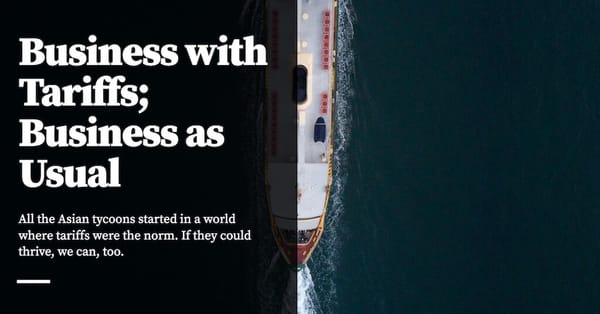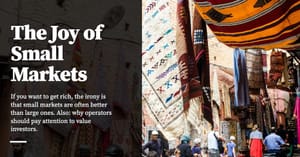Every Asian Tycoon we’ve examined got their start in a world with tariffs. They could thrive and adapt under severe uncertainty. So can we. Here’s how to calibrate for that world.
Note: This is Part 9 in a series of articles and cases on Asian Conglomerates. Read Part 8 here. You may read more about the Asian Conglomerate Series here, or view all the published cases here.
There’s this old saying that the past is a foreign land. This has never been more true in the past handful of weeks.
On the 2nd of April, 2025, US President Donald Trump declared ‘Liberation Day’ and announced tariffs on just about every polity in the world. This wasn’t entirely a surprise — Trump had been telegraphing tariffs for some time, and in the 24 hours immediately following the announcement, the S&P 500 returned to price levels from just a month before. Taken by itself, this was interesting: was the market sluggish in interpreting the news? Had word of the tariffs leaked via backchannels, leading to a market that had already priced it in? But then the question didn’t matter: news of retaliatory tariffs began pouring in from around the world, and the US stock market started to nose dive.
Amongst my investor friends, conversation rapidly turned from immediate market impact to positioning for the coming world order. In my broader circles, a few friends held out with the hope that ‘things would return to normal’ — and took the opportunity to make fun of Trump. But this, too, was short-lived — especially when Singaporean Prime Minister Lawrence Wong (Singapore being a major beneficiary of the free trade era) released a video declaring the end of the current world order, compared the tariff announcements to the Smoot-Hawley Tariff Act of 1930, and then described it as one of the proximal causes to the lead up to World War II. Singaporeans tend to pay attention to their own prime minister.
But the truth is that this isn’t really completely new. I had spent the last couple of months knee-deep in the research for the Asian Conglomerate series — which meant that when the announcements came out, I found myself — surprisingly — unperturbed. I’d seen this before. This was a return to a world we’d left behind. This was the world that so many of the tycoons we’d studied had lived in.
If you’ve been following the series, perhaps you’ve noticed this. Peppered in the background of so many of the cases we’ve seen is a changing world order — an order at least twice removed from our current one. All the Asian tycoons we’ve seen started with one foot in the colonial era. They had their founding business experiences around WWII, and then grew their business concerns in the post-colonial period, a time of great nationalism and often violent independence movements. Chaos and uncertainty was the norm. More importantly, tariff protection within the various (declining) empires was normal. The peaceful period we live in today — the 36 years or so since the fall of the Berlin Wall in 1989 — is more unusual if thrown up against the full theatre of time. We’ve gotten used to free trade.
The tycoons we have studied together had no such foundational experiences. Stanley Ho, B.C Lee, Dhirubhai Ambani, Robert Kuok, Kwek Hong Png and at least three generations of Tatas all ran their businesses under the shadow of great tariffs. And so one of the nice things about reading such cases is that you can better calibrate the changes that may be coming our way.
In this instalment of the Asian Conglomerates series, I want to show you how to do this.
Learning to See
Most people don’t read much history. (Some of you — Commoncog regulars — do, and if so, I apologise in advance, this bit is going to be old hat to you.) One thing that might not be obvious, that only emerges after you’ve spent enough time reading non-fiction narrative, is that the background to historical narrative is actually really important to pay attention to. This is a skill that avid history readers pick up by osmosis and it is a thing that novice readers tend to miss.
What do I mean by ‘the background’? Well, when you read a piece of historical narrative — in any format — there is doubtless going to be several sections that reads something like this:
In the years immediately after World War II, the gold trade was probably the most important — and certainly the most lucrative — monopoly in Macau. The second most lucrative monopoly was gambling, which for most of its history made up the majority of the colony’s tax revenue. But in the years 1944 through to 1971, gold was more important to Macau than gambling, and many tycoons — Ho Yin and Lobo included, built their business empires off the back of the gold trade.
The reason for this was pure chance. Portugal had been neutral for much of World War II, which meant that it was not a signatory for the 1944 Bretton Woods Agreement, which fixed exchange rates and restricted world trade in gold. Amongst other things, Bretton Woods banned imports of gold for individual use and stipulated that a troy ounce of gold would always cost US$35 (US$623.81 in 2024 dollars). This was great for Macau: it was a colony of Portugal, Portugal was not a signatory, and as a result Macau became the global hub for gold smuggling nearly overnight. Lobo and his cartel would purchase gold from Russia and Mexico legally, at cheap prices (these were, like Portugal, non-signatories to Bretton Woods) and then sell the gold on the open market at US$35, pocketing the massive profits.
We are so used to seeing snippets like this that we don’t pay much attention to it. Typically, such background information is incidental to the primary narrative of the biography or case. It’s only after you read multiple biographies that all occur in the same period that the background begins to adds up.
What I mean by this is that you begin to realise that there are more things going on in the world than the narrative lets on. These things are world events that your subject was likely aware of, that he or she was reading in the news, that was discussed in dinner conversations in their time. And you’d begin to realise that the world these historical subjects lived in, the cares and worries of the societies they grew up in, are not like your own.
Originally published , last updated .
This article is part of the Operations topic cluster, which belongs to the Business Expertise Triad. Read more from this topic here→
This article is part of the Market topic cluster, which belongs to the Business Expertise Triad. Read more from this topic here→





